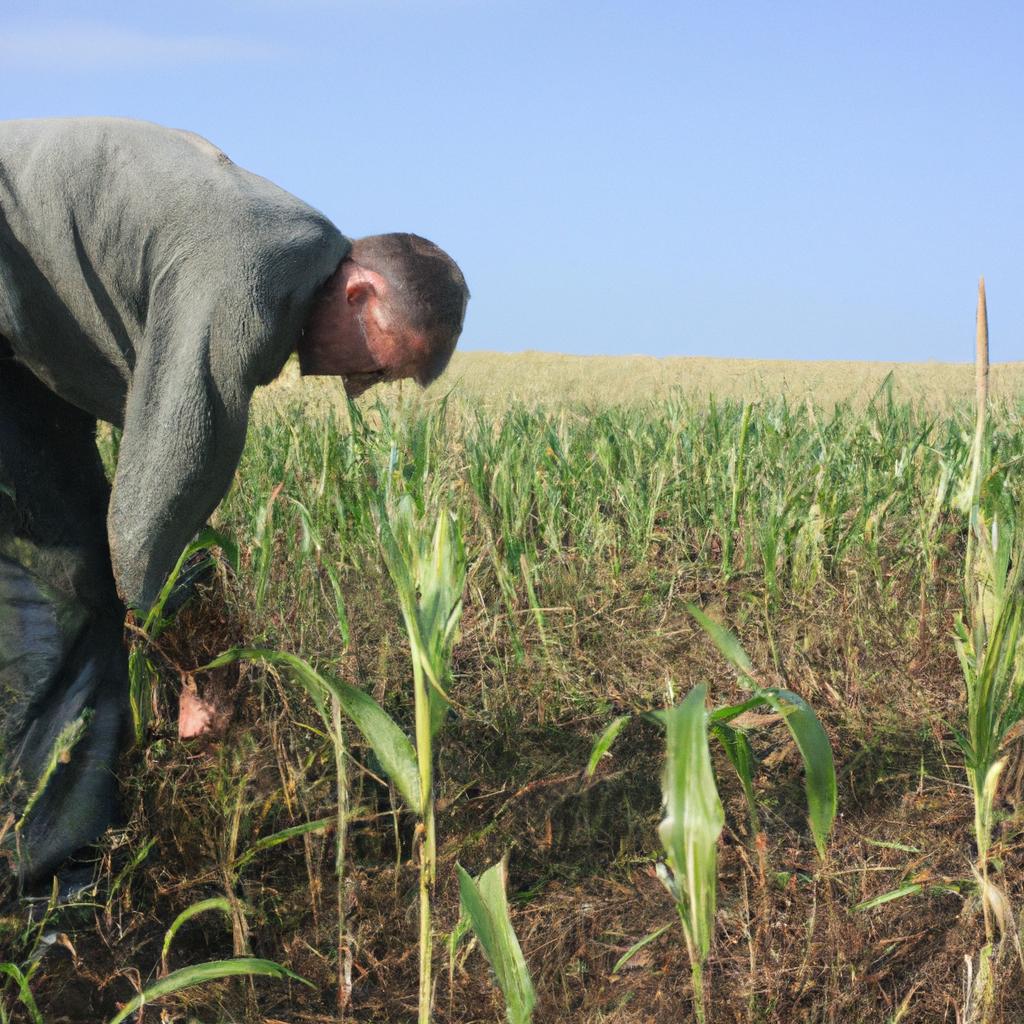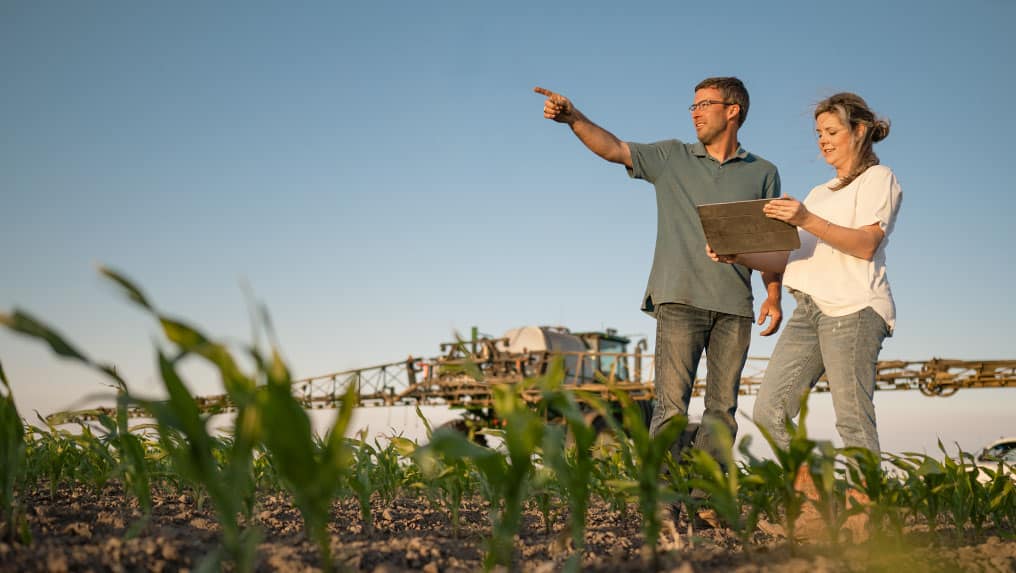Farmland investments have emerged as a lucrative opportunity in the realm of agri-finance, offering compelling prospects for individuals and institutions seeking to diversify their investment portfolios. The potential benefits derived from investing in farmland extend beyond monetary gains, encompassing environmental sustainability, food security, and rural development. For instance, consider the case study of Green Acres Investment Group, which acquired a vast tract of agricultural land in Central California. By implementing sustainable farming practices and modern technology, they not only achieved significant financial returns but also contributed to regional economic growth and enhanced resource conservation.
In recent years, the global demand for agricultural products has been on an upward trajectory due to population growth and changing dietary patterns. This surge in demand has intensified the need for increased agricultural productivity and efficient management systems. As a result, investors are increasingly looking towards farmland investments as a means of capitalizing on this burgeoning market. However, navigating the complexities of agri-finance requires astute decision-making and comprehensive understanding of various factors such as land valuation methods, agronomic practices, commodity pricing dynamics, regulatory frameworks, and risk mitigation strategies. To make informed investment decisions in this sector demands careful analysis of both quantitative data (e.g., historical yield trends) and qualitative aspects (e.g., such as soil quality and water availability).
One of the key considerations when evaluating farmland investments is land valuation. Various methods exist for assessing the value of agricultural land, including comparable sales approach, income capitalization approach, and cost approach. Each method accounts for different factors such as location, productivity potential, infrastructure, and market conditions. Conducting thorough research and consulting with experts in agri-finance can help investors determine a fair price for the farmland they are considering.
Agricultural practices also play a crucial role in the success of farmland investments. Understanding agronomic practices specific to the region and crop types is essential for optimizing yields and minimizing production risks. Factors such as crop rotation, irrigation techniques, pest management strategies, and soil health management need to be carefully considered to ensure long-term sustainability and profitability.
Commodity pricing dynamics have a significant impact on farmland investments as well. Investors must stay informed about global market trends, demand-supply dynamics, trade policies, and geopolitical factors that influence commodity prices. This knowledge enables them to make strategic decisions regarding crop selection and timing of sales to maximize returns.
Regulatory frameworks governing agriculture vary across jurisdictions and can significantly impact farmland investments. Understanding zoning regulations, environmental compliance requirements, water rights laws, and tax incentives available for agricultural activities is crucial for mitigating legal risks and maximizing financial benefits.
Risk mitigation strategies are vital in any investment endeavor. In farmland investments specifically, risks include weather-related events (e.g., droughts or floods), pest outbreaks or diseases impacting crops, fluctuations in commodity prices or input costs (e.g., fertilizers or fuel), changes in government policies affecting agriculture subsidies or trade agreements, among others. Diversification through portfolio allocation across different regions or crop types can help mitigate some of these risks.
In conclusion, investing in farmland offers compelling prospects beyond monetary gains by contributing to environmental sustainability, food security, and rural development. However, navigating the complexities of agri-finance requires comprehensive understanding of various factors such as land valuation methods, agronomic practices, commodity pricing dynamics, regulatory frameworks, and risk mitigation strategies. Making informed investment decisions in this sector demands careful analysis of both quantitative data and qualitative aspects.
The Importance of Farmland Investments
Investing in farmland has emerged as a lucrative opportunity for many investors seeking to diversify their portfolios and generate stable returns. One compelling example that showcases the potential benefits of farmland investments is the case of Smith Farms, a fictional company that decided to allocate a portion of its investment capital towards agricultural land. By acquiring several parcels of farmland across different regions, Smith Farms was able to not only secure a consistent source of income through leasing agreements with farmers but also benefit from the appreciation in land values over time.
There are several reasons why farmland investments have gained traction among savvy investors. Firstly, farmland serves as an essential resource for food production, making it an indispensable component of global supply chains. As the world population continues to grow, the demand for agricultural products is expected to rise significantly, creating a favorable market environment for those invested in this sector. Additionally, unlike other asset classes such as stocks or bonds which can be subject to volatility and economic downturns, farmland offers relative stability due to its tangible nature and limited supply.
To further emphasize the significance of investing in farmland, consider these thought-provoking points:
- Land scarcity: With urbanization on the rise and competing demands for land use, available arable land is becoming increasingly scarce.
- Climate change resilience: Farmlands possessing resilient characteristics such as good soil quality and reliable access to water resources are more likely to withstand climate-related challenges.
- Environmental impact mitigation: Sustainable farming practices implemented on well-managed farms can contribute positively toward environmental conservation efforts.
- Social responsibility: Investing in agriculture helps support local communities by enhancing food security and rural livelihoods.
| Benefits of Farmland Investments | |
|---|---|
| 1 | Potential long-term growth and appreciation |
| 2 | Diversification within an investment portfolio |
| 3 | Hedge against inflation |
| 4 | Opportunity for socially and environmentally responsible investing |
In summary, farmland investments offer a unique blend of financial returns, stability, and the potential to make a positive impact on both society and the environment. Understanding the Agriculture and Forestry Sectors will provide further insights into the dynamics that shape these industries and help investors navigate opportunities within them.
Understanding the Agriculture and Forestry Sectors
Building upon the significance of farmland investments, let us now delve into a comprehensive understanding of the agriculture and forestry sectors. To illustrate their interconnectedness and potential for agri-finance opportunities, consider the following example:
Example: Imagine a small-scale farmer named Sarah who owns a parcel of land in rural Iowa. She has been cultivating corn crops on her farm for years but is looking to diversify her operations due to fluctuating market conditions. After conducting thorough research, she decides to venture into timber production alongside traditional crop cultivation.
Firstly, it is crucial to recognize that both the agriculture and forestry sectors play vital roles in sustaining global food security, biodiversity conservation, and natural resource management. These sectors are interrelated through various practices such as agroforestry systems, where trees are integrated into agricultural landscapes to enhance soil fertility and provide additional income streams.
Secondly, investing in these sectors offers several advantages beyond financial returns. By supporting sustainable farming practices and responsible forest management, investors can contribute to mitigating climate change impacts by sequestering carbon dioxide in soils and forests. Furthermore, these investments have the potential to promote social development by generating employment opportunities within local communities.
- Enhanced environmental sustainability
- Improved resilience against climate change impacts
- Promotion of rural livelihoods
- Preservation of cultural heritage associated with farming traditions
Additionally, visualizing the possibilities fosters an emotional connection; hence we present this table showcasing key aspects of agriculture and forestry investments:
| Aspect | Agriculture Investments | Forestry Investments |
|---|---|---|
| Resource Utilized | Land | Timber |
| Time Horizon | Short-term (annual harvest) | Long-term (decades or longer) |
| Market Dynamics | Seasonal fluctuations | Less volatility, long-term |
| Risk Profile | Weather conditions, pests | Fire risks, market fluctuations |
To conclude this section and transition to the next, it is evident that agriculture and forestry sectors present promising agri-finance opportunities. Understanding their interconnectedness and potential benefits beyond financial returns can help investors make informed decisions when considering farmland investments.
With a comprehensive understanding of the agriculture and forestry sectors in mind, let us now explore key factors to consider in farmland investing.
Key Factors to Consider in Farmland Investing
To gain a deeper understanding of the agriculture and forestry sectors, let us consider a hypothetical case study. Imagine a potential investor named John who is interested in farmland investments. He wants to explore opportunities within business agriculture and forestry, but he seeks greater knowledge about these sectors before making any investment decisions.
Firstly, it is important to comprehend the key factors that contribute to success or failure in agricultural and forestry ventures. These factors can broadly be categorized into four main areas:
- Market demand: Understanding consumer trends and preferences for agricultural products such as crops, livestock, timber, or renewable energy sources is crucial. This knowledge enables investors like John to identify which industries are likely to yield higher returns on their farmland investments.
- Environmental considerations: Sustainability practices play an increasingly significant role in modern agriculture and forestry operations. Investors need to assess how well prospective farms align with environmental regulations and sustainable farming methods.
- Technological advancements: The adoption of innovative technologies has revolutionized both agriculture and forestry by increasing efficiency, improving yields, reducing costs, and minimizing environmental impact. It is essential for investors like John to evaluate whether specific farms leverage advanced equipment or techniques.
- Government policies: Policies related to land use, subsidies, tariffs, trade agreements, tax incentives, and other regulatory measures significantly influence profitability in the agriculture and forestry sectors. Staying informed about government interventions helps investors anticipate market fluctuations accurately.
Now let’s delve into more detail through a table that highlights some key differences between the agriculture sector (crops) and the forestry sector (timber):
| Aspect | Agriculture Sector | Forestry Sector |
|---|---|---|
| Harvest Cycle | Annual | Decades |
| Land Requirement | Smaller per unit | Larger per unit |
| Profitability | Generally quicker | Long-term investment |
| Environmental Impact | Crop rotation required | Sustainable practices |
As we can see from the table, agriculture and forestry sectors differ in terms of harvest cycles, land requirements, profitability timelines, and environmental impact. However, both offer unique opportunities for farmland investments.
In conclusion, understanding the various aspects of the agriculture and forestry sectors is crucial for making informed investment decisions. Market demand, environmental considerations, technological advancements, and government policies are key factors that potential investors should assess before venturing into these industries.
Exploring Different Types of Farmland Investments
Transitioning from the previous section on key factors to consider in farmland investing, it is important to explore different types of farmland investments. By understanding the various options available, investors can make informed decisions that align with their financial goals and risk tolerance.
One example of a type of farmland investment is purchasing agricultural land for crop production. This involves acquiring land suitable for growing crops such as grains, fruits, or vegetables. Investors who choose this option often lease the land to farmers who have expertise in specific crop cultivation. This allows them to generate income through rental payments while also benefiting from potential appreciation in land value over time.
When considering different types of farmland investments, there are several factors to take into account:
- Location: The location of the farmland plays a crucial role in determining its profitability. Factors such as climate suitability for certain crops, proximity to markets, and access to necessary infrastructure should be carefully evaluated.
- Soil Quality: Assessing the soil quality is essential as it directly impacts crop productivity. Conducting soil tests can provide valuable information about nutrient levels and potential limitations for specific crops.
- Water Availability: Adequate water resources are vital for successful agriculture. Evaluating the availability and reliability of water sources, such as rivers or wells, is crucial when assessing an investment opportunity.
- Regulatory Considerations: Understanding local regulations related to farming practices, zoning restrictions, permits, and environmental policies is imperative before making any investment decision.
To further illustrate these considerations, here is a table summarizing how they apply to two hypothetical farmland investment opportunities:
| Investment Opportunity | Location | Soil Quality | Water Availability | Regulatory Considerations |
|---|---|---|---|---|
| Option A | Prime farmland in a region known for its ideal climate conditions | Rich loamy soils | Nearby river provides consistent water supply | Favorable government policies promoting agricultural investments |
| Option B | Remote farmland in an arid region with limited access to markets | Sandy soils with low fertility | Limited water resources, relying heavily on irrigation systems | Stringent regulations regarding water usage and environmental impact |
By carefully considering these factors and conducting thorough due diligence, investors can identify the type of farmland investment that aligns best with their objectives. In the subsequent section, we will delve into evaluating risks and rewards associated with agricultural investments seamlessly.
Note: Please remember to convert this markdown format table into a properly formatted table when using it outside of Markdown environments.
Transitioning into the next section about “Evaluating Risks and Rewards in Agricultural Investments,” we now turn our attention towards assessing the potential challenges and opportunities that arise from investing in farmland.
Evaluating Risks and Rewards in Agricultural Investments
In the previous section, we delved into the various types of farmland investments available to potential investors. Now, let us examine some specific examples that highlight the diverse opportunities within this sector.
Consider a hypothetical case study involving an investor named Jane. She decides to invest in a large-scale commercial vegetable farm located in California’s fertile Central Valley region. This type of investment offers several advantages, including stable cash flow from crop sales and long-term appreciation due to increasing demand for fresh produce.
When evaluating different types of farmland investments, it is important to consider the following factors:
-
Geographic Location:
- Accessible transportation infrastructure.
- Proximity to major markets and distribution centers.
- Availability of water resources and favorable climate conditions.
-
Farming Operations:
- Diversity of crops or livestock produced.
- Efficiency and sustainability practices employed.
- Technological advancements implemented for increased productivity.
-
Market Demand:
- Consumer preferences and trends.
- Export potential and international market access.
- Relationship between supply and demand dynamics.
-
Regulatory Environment:
- Compliance with local agricultural regulations.
- Environmental stewardship measures undertaken.
- Potential policy changes impacting land use or farming practices.
To further illustrate these considerations, let us take a look at the table below which compares two different types of farmland investments: one focusing on row crops (such as corn or soybeans) in the Midwest United States, and another centered around vineyards in Napa Valley, California.
| Factors | Row Crop Investment | Vineyard Investment |
|---|---|---|
| Geographic Location | Iowa/Missouri | Napa Valley, California |
| Farming Operations | Large-scale mechanized farming | Boutique wineries |
| Market Demand | Commodity-driven global market | Premium wine market |
| Regulatory Environment | Favorable agricultural policies | Strict zoning regulations and wine standards |
As we can see, these two types of farmland investments differ significantly in terms of geographic location, farming operations, market demand, and regulatory environment. Assessing each factor is crucial for making informed investment decisions.
Understanding these factors is vital to ensure a successful venture in this dynamic industry.
Moving forward, let us now explore how to evaluate the potential risks and rewards involved in agricultural investments.
Steps to Successfully Invest in Farmland
From evaluating the risks and rewards in agricultural investments, we now move on to understanding the steps required for successful investment in farmland. To illustrate these steps, let us consider a hypothetical scenario involving an investor named John who is considering investing in a large plot of arable land.
Firstly, John must conduct thorough research and due diligence before making any investment decisions. This involves analyzing various factors such as soil quality, climate conditions, water availability, and proximity to markets. By gathering comprehensive data on these aspects, John can assess the potential productivity and profitability of the farmland he intends to invest in.
Once John has identified a suitable piece of land, he should seek professional assistance from experts such as agricultural consultants or real estate agents specializing in rural properties. These professionals can provide valuable insights into market trends, regulatory requirements, and best practices for managing farmland investments. Engaging with experienced individuals will minimize uncertainty and increase the chances of success for John’s investment venture.
Furthermore, it is crucial for John to develop a solid business plan that outlines his objectives, strategies, and financial projections. This plan should encompass details about crop selection, farming techniques, operational costs, expected returns on investment, and risk management strategies. A well-crafted business plan not only helps secure financing but also serves as a roadmap for effective decision-making throughout the course of John’s investment journey.
To evoke an emotional response among prospective investors like John regarding the potential benefits of farmland investments, here are four key advantages:
- Long-term Stability: Farmland investments have historically demonstrated resilience during economic downturns.
- Tangible Asset: Unlike stocks or bonds which may fluctuate in value based on market sentiments alone, farmland represents a tangible asset with inherent value tied to its productive capabilities.
- Environmental Impact: Investing in sustainable agriculture practices can contribute positively towards environmental conservation efforts.
- Legacy Building: Owning farmland offers an opportunity to create a lasting legacy by nurturing fertile land for future generations.
In addition, let us consider a three-column table highlighting the financial benefits, social impact, and environmental sustainability of farmland investments:
| Financial Benefits | Social Impact | Environmental Sustainability |
|---|---|---|
| Steady Income | Job Creation | Sustainable Resource Usage |
| Diversification | Rural Development | Biodiversity Preservation |
| Inflation Hedge | Food Security | Carbon Sequestration |
By following these steps and considering the emotional appeal of farmland investment advantages presented through bullet points and a table, potential investors like John can make informed decisions that align with their long-term goals. Investing in agriculture offers not only financial rewards but also an opportunity to contribute positively to society and the environment.




